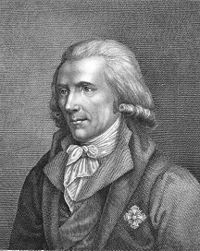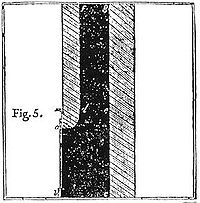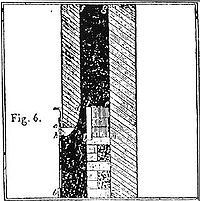
Rumford fireplace
Encyclopedia

Fireplace
A fireplace is an architectural structure to contain a fire for heating and, especially historically, for cooking. A fire is contained in a firebox or firepit; a chimney or other flue allows gas and particulate exhaust to escape...
designed by Sir Benjamin Thompson
Benjamin Thompson
Sir Benjamin Thompson, Count Rumford , FRS was an American-born British physicist and inventor whose challenges to established physical theory were part of the 19th century revolution in thermodynamics. He also served as a Lieutenant-Colonel in the Loyalist forces in America during the American...
, Count Rumford, born 1753 in Woburn, Massachusetts
Woburn, Massachusetts
Woburn is a city in Middlesex County, Massachusetts, USA. The population was 38,120 at the 2010 census. Woburn is located north of Boston, Massachusetts, and just south of the intersection of I-93 and I-95.- History :...
, an Anglo-American physicist
Physicist
A physicist is a scientist who studies or practices physics. Physicists study a wide range of physical phenomena in many branches of physics spanning all length scales: from sub-atomic particles of which all ordinary matter is made to the behavior of the material Universe as a whole...
who was known for his investigations of heat
Heat
In physics and thermodynamics, heat is energy transferred from one body, region, or thermodynamic system to another due to thermal contact or thermal radiation when the systems are at different temperatures. It is often described as one of the fundamental processes of energy transfer between...
.
Rumford applied his knowledge of heat to the improvement of fireplaces. He made them smaller and shallower with widely angled covings so they would radiate better. And he streamlined the throat, or in his words "rounded off the breast" so as to "remove those local hindrances which forcibly prevent the smoke from following its natural tendency to go up the chimney..."
Rumford wrote two papers detailing his improvements on fireplaces in 1796 and 1798. He was well known and widely read in his lifetime and almost immediately in the 1790s his "Rumford fireplace" became state-of-the-art worldwide.
Today, with the extensive restoration of old and historic houses and the renewed popularity of early American and classical architecture in new construction, Rumford fireplaces are enjoying a comeback. Rumford fireplaces are generally appreciated for their tall classic elegance and their heating efficiency.
Principle of action


Streamliner
A streamliner is a vehicle incorporating streamlining in a shape providing reduced air resistance. The term is applied to high-speed railway trainsets of the 1930s to 1950s, and to their successor "bullet trains". Less commonly, the term is applied to fully faired recumbent bicycles...
air flow, reducing turbulence
Turbulence
In fluid dynamics, turbulence or turbulent flow is a flow regime characterized by chaotic and stochastic property changes. This includes low momentum diffusion, high momentum convection, and rapid variation of pressure and velocity in space and time...
so the smoke would go up into the chimney rather than lingering and often choking the residents. Many fashionable London houses were modified to his instructions, and became smoke-free as well as more efficient. Thompson became a celebrity when news of his success became widespread. In an age when fires were the principal source of heat, this simple alteration in the design of fireplaces was copied everywhere .


Thomas Jefferson
Thomas Jefferson was the principal author of the United States Declaration of Independence and the Statute of Virginia for Religious Freedom , the third President of the United States and founder of the University of Virginia...
had them built at Monticello
Monticello
Monticello is a National Historic Landmark just outside Charlottesville, Virginia, United States. It was the estate of Thomas Jefferson, the principal author of the United States Declaration of Independence, third President of the United States, and founder of the University of Virginia; it is...
, and Thoreau listed them among the modern conveniences that everyone took for granted. There are still many original Rumford fireplaces, often buried behind newer renovations. He also invented a cast iron
Cast iron
Cast iron is derived from pig iron, and while it usually refers to gray iron, it also identifies a large group of ferrous alloys which solidify with a eutectic. The color of a fractured surface can be used to identify an alloy. White cast iron is named after its white surface when fractured, due...
stove
Stove
A stove is an enclosed heated space. The term is commonly taken to mean an enclosed space in which fuel is burned to provide heating, either to heat the space in which the stove is situated or to heat the stove itself, and items placed on it...
which competed successfully with the famous Benjamin Franklin
Benjamin Franklin
Dr. Benjamin Franklin was one of the Founding Fathers of the United States. A noted polymath, Franklin was a leading author, printer, political theorist, politician, postmaster, scientist, musician, inventor, satirist, civic activist, statesman, and diplomat...
stove
Franklin stove
The Franklin stove is a metal-lined fireplace named after its inventor, Benjamin Franklin. It was invented in 1741.L.W. Labaree, W. Bell, W.B. Willcox, et al., eds., The Papers of Benjamin Franklin , vol. 2, page 419...
. Both devices gave much more control over the air flow into the fire, and were both much more efficient users of fuel. Such stoves were expensive, but saved so much fuel as to justify the cost of installation very quickly.
External links
- Dr. Hugh C. Rowlinson "The Contribution of Count Rumford to Domestic Life in Jane Austen’s Time" An article not only detailing the Rumford fireplace, but also Rumford's life and other achievements.

